A Private Tour today, the first of two days. It was a lovely bright day, sunny at times, although with a nagging and blustery westerly wind. We headed up into north-west Norfolk for the day.
With a big high tide expected this morning, we headed up to Snettisham. It was not going to be big enough to force all the waders off the Wash today, but it should have been enough to concentrate them into the last corner of mud.
When we arrived, the tide was already coming in fast. We stopped to scan the mud and could immediately see a large mob of Oystercatchers gathered ahead of the rising water, a big black smear across the grey mud. The smear was moving too, flowing, as the birds walked en masse, steadily and sedately away from the incoming water.
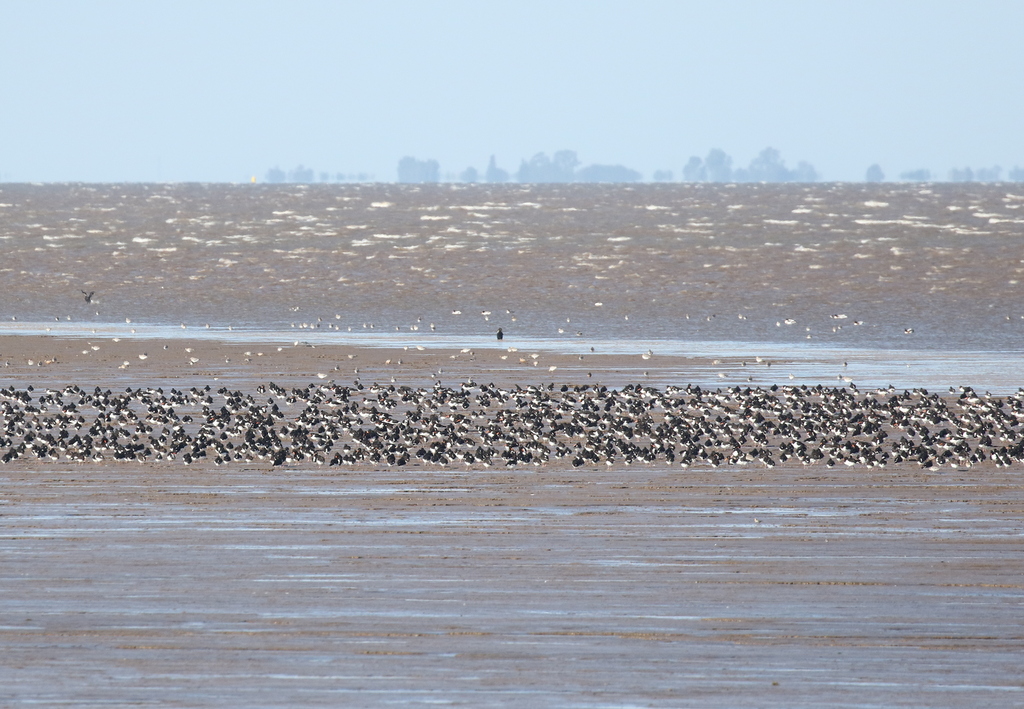 Oystercatchers – gathering on the mud ahead of the rising tide
Oystercatchers – gathering on the mud ahead of the rising tide
Further over, we could see a scattering of paler grey dots. Through the scope we could see they were Knot, Bar-tailed Godwit and Grey Plover. Most of the Knot were further down the Wash today, in the next bay round, but we could see them from time to time when they took off and whirled round, thousands and thousands of them.
Some smaller waders were taking advantage of the remaining mud to feed. There were plenty of Dunlin and Ringed Plover in front of all the Oystercatchers. A couple of Turnstone and a lone Knot flew in and landed on the mud down in front of us, on the nearside of the channel. The Knot tried to go to sleep, but with the tide still rising it wasn’t long before they were all pushed off again. A small party of Golden Plover flew past.
We continued on down the path, trying to keep ahead of the tide. A line of Bar-tailed Godwits were standing in the water close to the Oystercatchers. Through the scope, we could see that some were still sporting the remnants of their rusty breeding plumage. Some of the Grey Plover further over were also still looking smart, with black faces and bellies still, not yet moulted into their drabber grey winter plumage.
Several Common Terns flew past, in and out of the pits behind us, calling. Two Sandwich Terns were flying around over the water and landed on the shore in with the Oystercatchers. Through the scope, we could see the yellow tip to the black bill of the adult Sandwich Tern.
A raft of ducks had gathered on the water at the mouth of the channel, swimming in with the tide. Most of them were Mallard, but in with them we could see a couple of Wigeon. A single Pintail flew in and landed with them too. Three Teal flew off.
With the time getting on towards high tide, it quickly became clear that the tide would not rise as high as predicted today. The blustery wind was holding back the water. Something flushed the Knot, possibly they were just jumpy in the wind, but they landed back down where they had come from and didn’t come round onto the bay in front of us today. More Oystercatchers were trying to roost further north, along the seawall, but were disturbed. A couple more huge flocks of them flew in and landed down on the mud with the ones already in front of us. The Curlew had already retreated to the edge of the saltmarsh and gone to sleep.
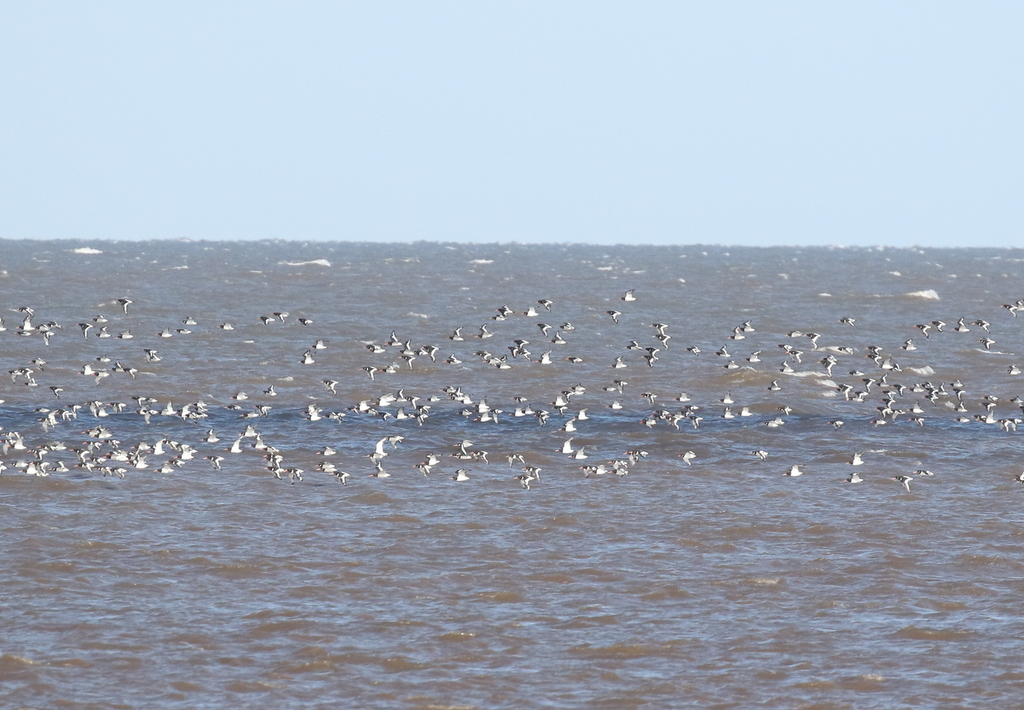 Oystercatchers – flying into join the others on the mud
Oystercatchers – flying into join the others on the mud
As the tide went slack, we could see a couple of Marsh Harriers out over the saltmarsh. They flushed a couple of Greenshanks which flew round in front of us. A Yellow Wagtail flew over calling. We turned and headed into Shore Hide to look at the pits.
There were loads of geese on the pits today, mostly Greylags, but in with them we could see a few Canada Geese and Egyptian Geese too. They had taken up occupation of many of the islands. In between them, we could see several Common Terns. They were mostly juveniles, particularly the three or four in front of the hide. An adult flew in to join them carrying a fish, but none of the youngsters seemed to show any particular interest in being fed.
With most of the waders staying out on the Wash today, there were not so many out on the islands in the pit. Just one of the islands had any waders on it and that one was jam-packed, mostly with Black-tailed Godwits. Around the edge were the Common Redshanks and in between the godwits we could just make out some Knot wedged in too.
There are normally some Spotted Redshanks here and they were roosting in their usual place, out in the middle of the water. They were hard to see at first among all the Greylags, but eventually the melee cleared enough for us to see that there were 14 Spotted Redshanks, mostly silvery grey and white winter adults. One bird still had significant remnants of breeding plumage, being heavily specked with black below. There were also several dusky juveniles.
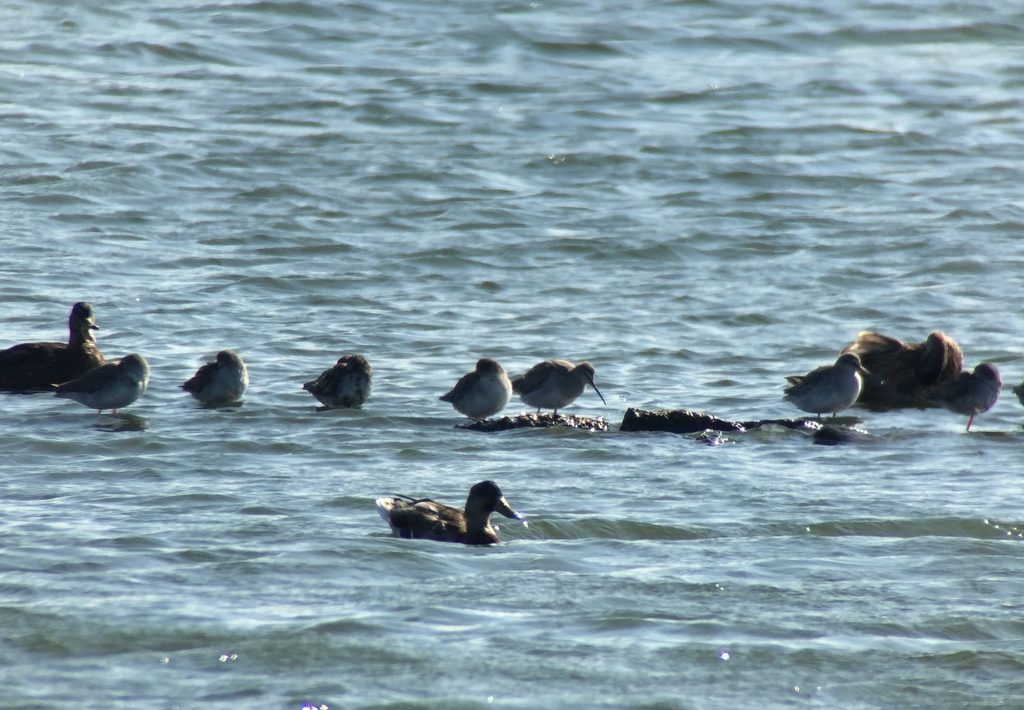 Spotted Redshanks – some of the 14 roosting on the pit today
Spotted Redshanks – some of the 14 roosting on the pit today
Having had a good look round the pit, we decided to head back to the car. As we walked along the path, something spooked all the birds on the pit. It may have just been just the Greylag Geese taking off to head to the fields to feed at first, but once they took to the air calling noisily, everything else followed.
All the waders which had been packed in on the island took off. Several big flocks of Black-tailed Godwits and Knot flew up and headed back towards the Wash, passing low over our heads as they did so. All we could hear was the beating of the Knots’ wings as they came over us. The Black-tailed Godwits were not beating their wings as quickly and did not produce the same effect.
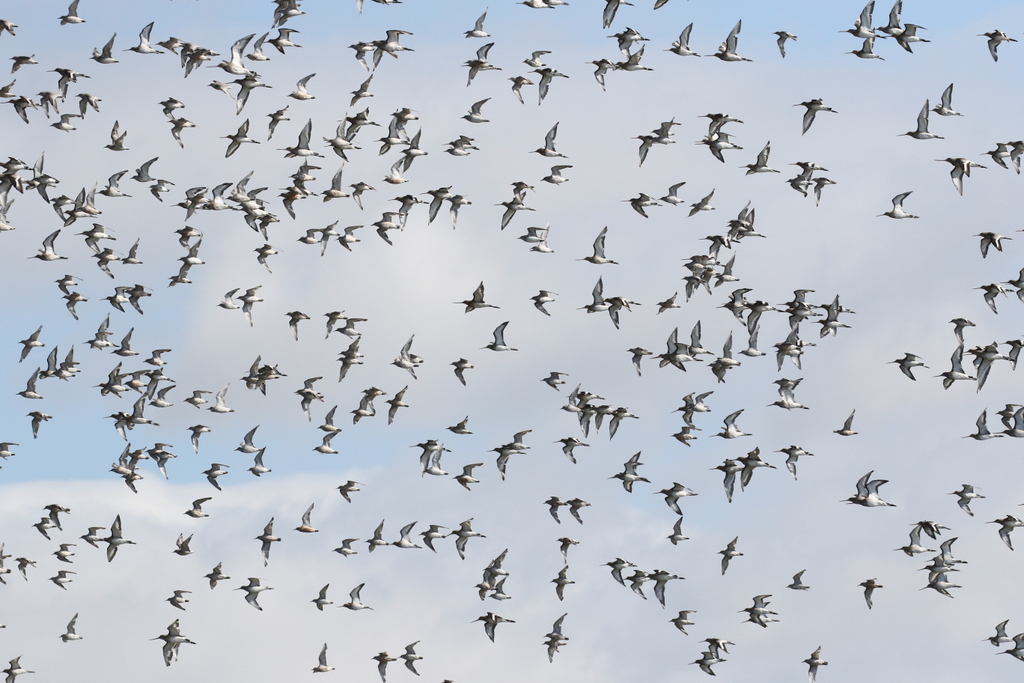 Black-tailed Godwits & Knot – flying back to the Wash
Black-tailed Godwits & Knot – flying back to the Wash
Our next destination was Titchwell. When we got round there, we thought we might not be able to park at first, the car parks were full to bursting. In the end, we found a single space along the entrance road. Unbelievably busy for a midweek day out of high season! As we got out of the car, a tit flock was feeding in the trees by the road, Long-tailed Tits, Blue Tits and Great Tits. We could hear a Coal Tit and a Treecreeper calling and a Chiffchaff was singing half-heartedly. A Goldcrest flitted around in a hawthorn just in front of us.
 Long-tailed Tit – in the trees along the entrance road
Long-tailed Tit – in the trees along the entrance road
Over an early lunch at the visitor centre, a Common Buzzard circled lazily overhead. After lunch, a quick look at the feeders produced a few Chaffinches and a single Greenfinch, as well as a few more tits. Then we headed out to explore the reserve.
As we passed the grazing marsh on the Thornham side, a Kestrel was hovering out over the grass. A Marsh Harrier circled distantly out across the saltmarsh. Passing the reedbed, we heard Bearded Tits calling close to the path but they were keeping well tucked down out of the wind today. A Cetti’s Warbler shouted at us from deep in cover too.
There were just a few Mallard on the reedbed pool today, and a single Teal appeared at the front. A Curlew was out on the saltmarsh opposite.
 Curlew – out on the saltmarsh
Curlew – out on the saltmarsh
From the shelter of Island Hide, we stopped to scan the freshmarsh. There are still lots of Ruff here, one of the most confusing of the waders. The adults are now in winter plumage, whitish below and grey brown above. The darker juveniles come in a range of buffs, browns and tawnies and look rather different to the grown-ups. With the males and females side by side, we could see the big size difference between the two, which just adds to the confusion.
 Ruff – a buff/brown juvenile
Ruff – a buff/brown juvenile
There were lots of Black-tailed Godwits and Lapwings in the deeper water over towards the reeds. Most of the Avocets have departed now, gone south for the winter, but we found a small number still lingering here. Two juvenile Little Stints had been reported earlier and it didn’t take us long to find them, feeding around the edge of one of the muddy islands out in the middle. They looked tiny next to the Black-headed Gulls. A juvenile Spotted Redshank dropped in briefly nearby.
While we were looking through the waders, we could hear Bearded Tits calling periodically. We kept looking over and scanning the edge of the reeds. One of the group went over and camped down in that end of the hide, and was eventually rewarded with a brief view of one down in the base of the reeds. Unfortunately, it had gone back in by the time the rest of us got over there. It really was a bit too windy here today, even the normally sheltered edge of the reeds was being caught by the wind.
As we walked round to Parrinder Hide along the main path, we had another scan of the freshmarsh and realised the Little Stints were much closer now to here. We stopped to look at them and through the scope we could see their prominent pale mantle lines or ‘braces’. They are on their way from the arctic tundra, where they were born, to the Mediterranean or Africa for the winter, stopping off here to feed on the way.
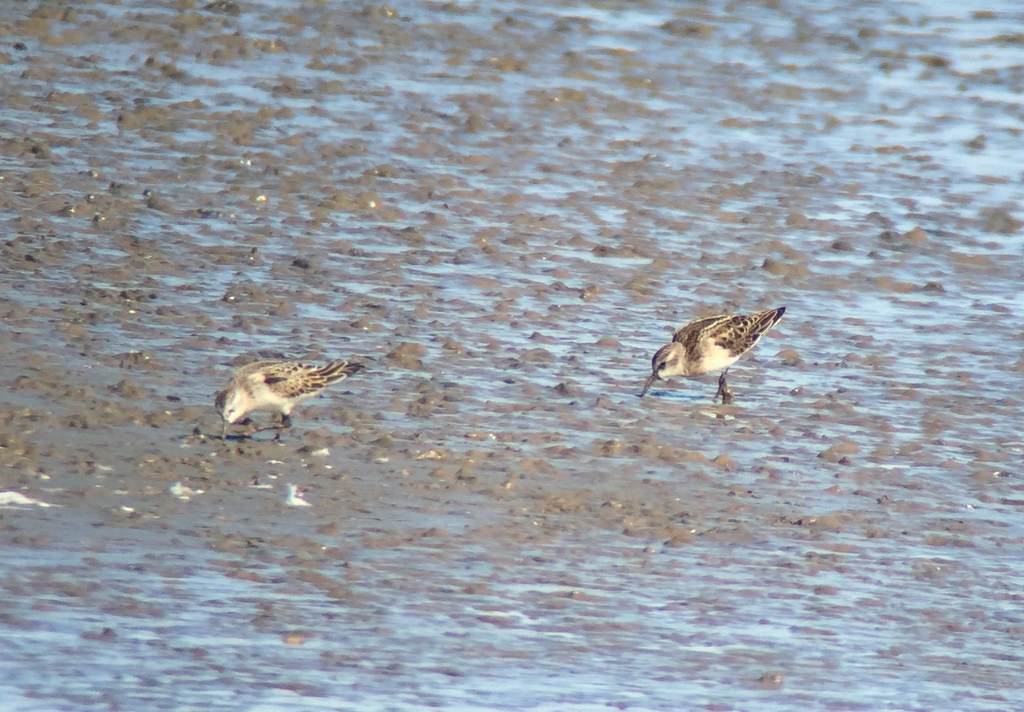 Little Stints – the two juveniles out on the freshmarsh today
Little Stints – the two juveniles out on the freshmarsh today
Looking out across the saltmarsh, we saw several Lapwings fly up and circle round before dropping back down into the vegetation further over. We realised there were quite a few Golden Plover out there too, but they were extremely well camouflaged against the golds and oranges of the saltmarsh plants. When we got them in the scope, they were easier to pick out.
From Parrinder Hide, there were several more Golden Plovers out on the islands amongst the sleeping ducks, Teal, Shoveler and Wigeon. We got one of the Golden Plovers in the scope so we could get a better look at it, admiring its gold spangled upperparts. A flock of Golden Plover then appeared overhead, calling plaintively. They dropped down to join the others on the freshmarsh, possibly some of the ones we had seen out on the saltmarsh earlier.
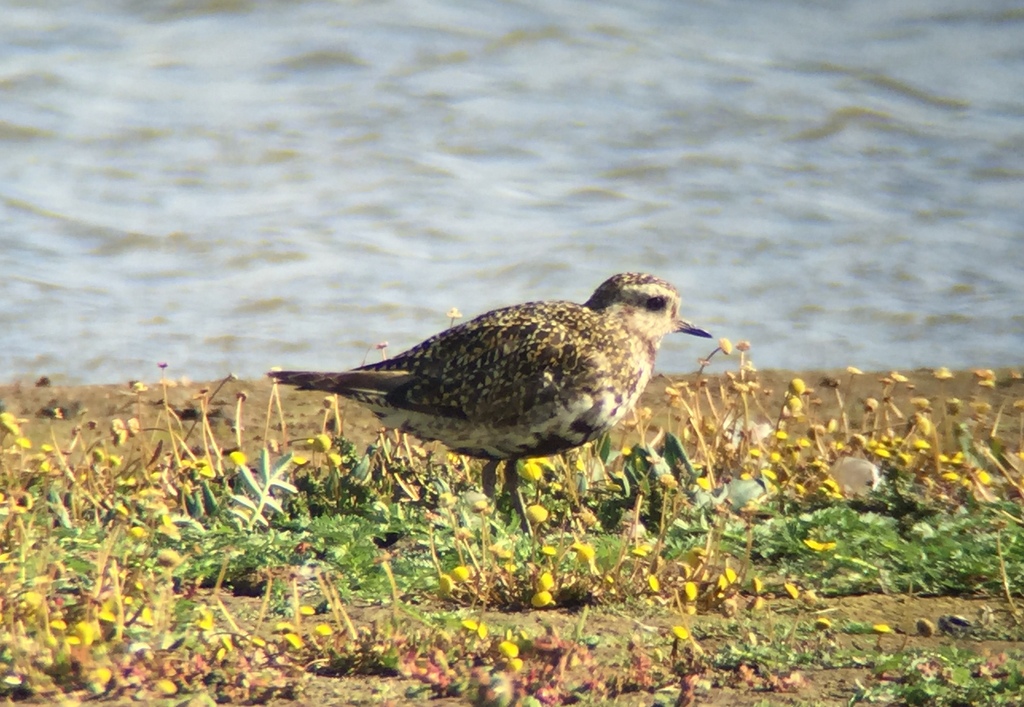 Golden Plover – several were out on the islands in the freshmarsh
Golden Plover – several were out on the islands in the freshmarsh
A sharp ‘tchuit’ call alerted us to an incoming Spotted Redshank, which dropped down into the water just to the left of the hide. A juvenile, presumably the one we had seen earlier, it started to feed close to the hide, sweeping its bill quickly from side to side in the deeper water as it walked round in circles. We got a great look at it, its needle fine bill, neat white supercilium and rather dusky grey overall plumage, speckled with pale on the back and wings.
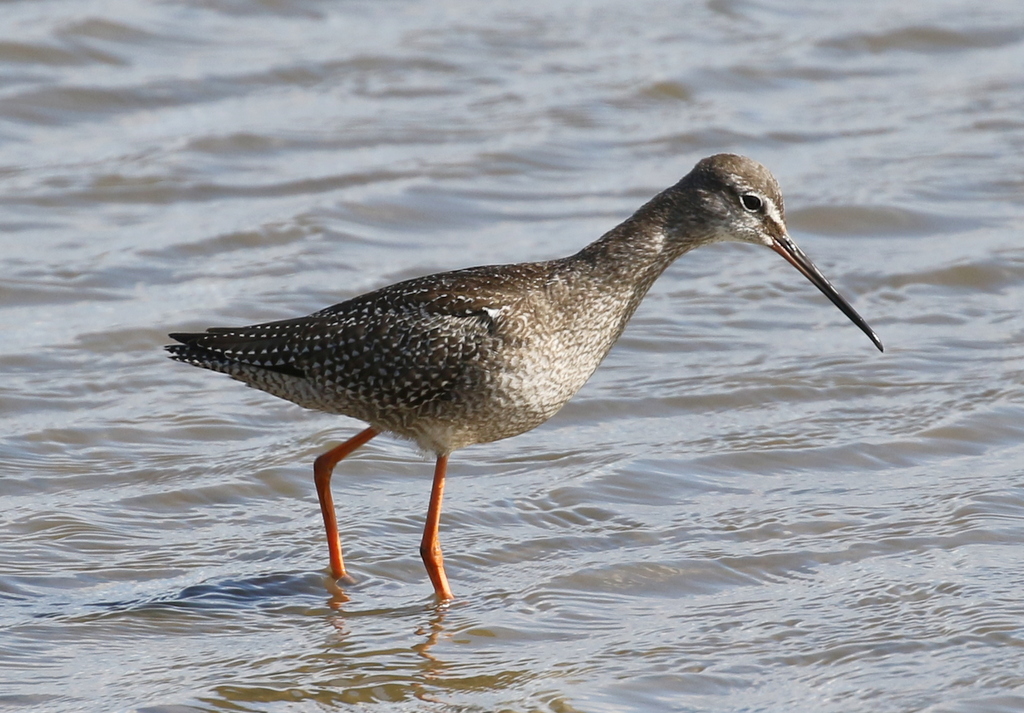 Spotted Redshank – this juvenile showed very well in front of Parrinder Hide
Spotted Redshank – this juvenile showed very well in front of Parrinder Hide
A quick look through the gulls from this side, produced nothing but Black-headed Gulls and Lesser Black-backed Gulls at first. Then we picked up a smart adult Yellow-legged Gull on one of the islands further over. We could see its custard-yellow legs and slightly darker upperparts compared to the Black-headed Gulls next to it.
While the weather was good, we decided to head out to the beach next. There was not much on the Volunteer Marsh at first, until we got almost to the bank at the far end and looked down along the channel. There were quite a few waders out on the muddy banks, mostly more Black-tailed Godwits, Redshank and Curlew. However there were three Grey Plover too and one was still in pretty much full breeding plumage, with black face and belly and white spangled upperparts. It looked stunning. The other two were already in much greyer winter plumage.
A Greenshank flew up from the freshmarsh behind us, calling, and flew off across the path and out towards Thornham Harbour. The tidal pools were rather quite, except for a few more Black-tailed Godwits and a single young Great Crested Grebe which was swimming in circles with its stripey head mostly down in the water, trying to spot potential prey.
Out at the beach, the tide was still going out. There were a few waders out on the mussel bed, mostly Oystercatchers and Bar-tailed Godwits, with a few Turnstones in with them. There were lots of Herring Gulls out here too. Scanning the sea, we picked up a female Common Scoter just offshore and a couple more Great Crested Grebes. Two Gannets flew past further out, as did a single Sandwich Tern. We couldn’t see anything else immediately offshore, and with some dark clouds behind us, we decided to head back.
As we walked back past the tidal pools, we heard a Whimbrel calling in the distance. We scanned and picked up two Whimbrel flying towards us, and they eventually came almost over our heads before continuing on west without stopping. A very obliging Black-tailed Godwit was feeding by the path as we passed.
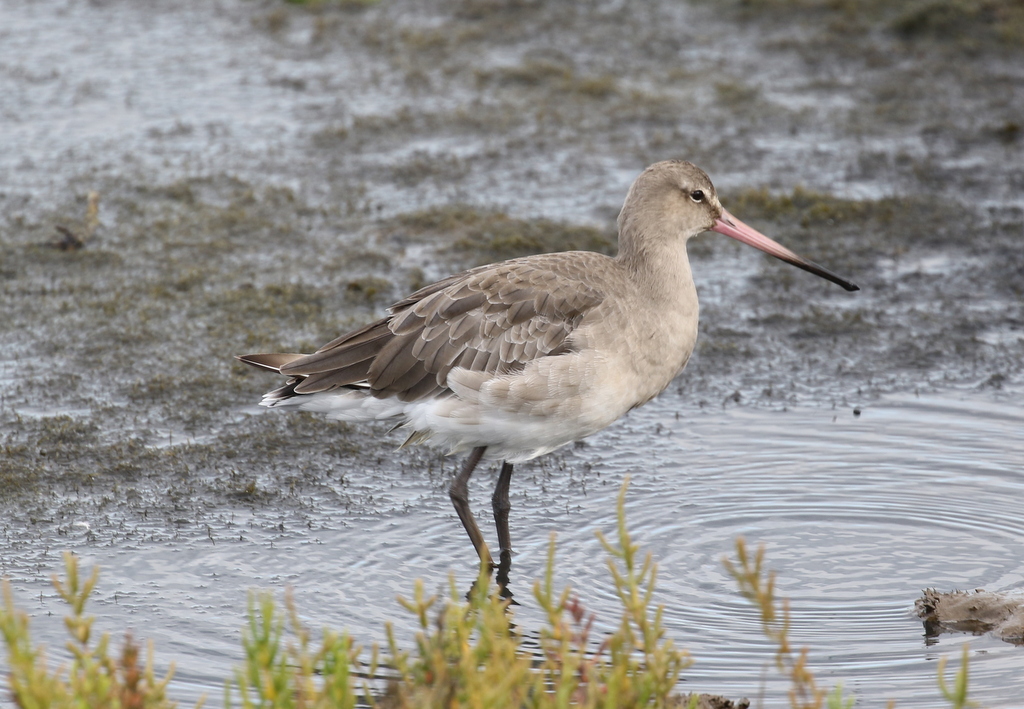 Black-tailed Godwit – feeding by the path on the tidal pools
Black-tailed Godwit – feeding by the path on the tidal pools
Back at the freshmarsh, we stopped for a quick scan again. There were more Black-headed Gulls here now and in amongst them we found a single 1st winter Mediterranean Gull, which proceeded to sit down and go to sleep. A single Dunlin had appeared and was feeding with the two Little Stints now, giving a great size comparison and again highlighting just how small the Little Stints are.
After a sit down and a cup of tea back at the visitor centre, we made our way back to the car. On the way home, we headed inland round via Choseley. Pulling up alongside the drying barns, all looked very quiet, so we carried on inland.
A flock of Goldfinches on the wires was the first thing of note we came across. A little further on, another bigger flock of birds on the wires were Linnets. We pulled up to take a quick look and noticed a few birds around the puddles in the edge of the field the other side of the road. They flew up into the hedge and we picked up first a Yellowhammer then a larger bird in the top of the bush above it. It was a single Corn Bunting, a real bonus. It was then joined by a Reed Bunting too.
The last bird of note was a Sparrowhawk which we disturbed from the road. It flew off low ahead of us, less than a foot above the tarmac, for some way until it found a gap in the hedge and disappeared. A nice end to the first day, lets hope for more tomorrow.
















